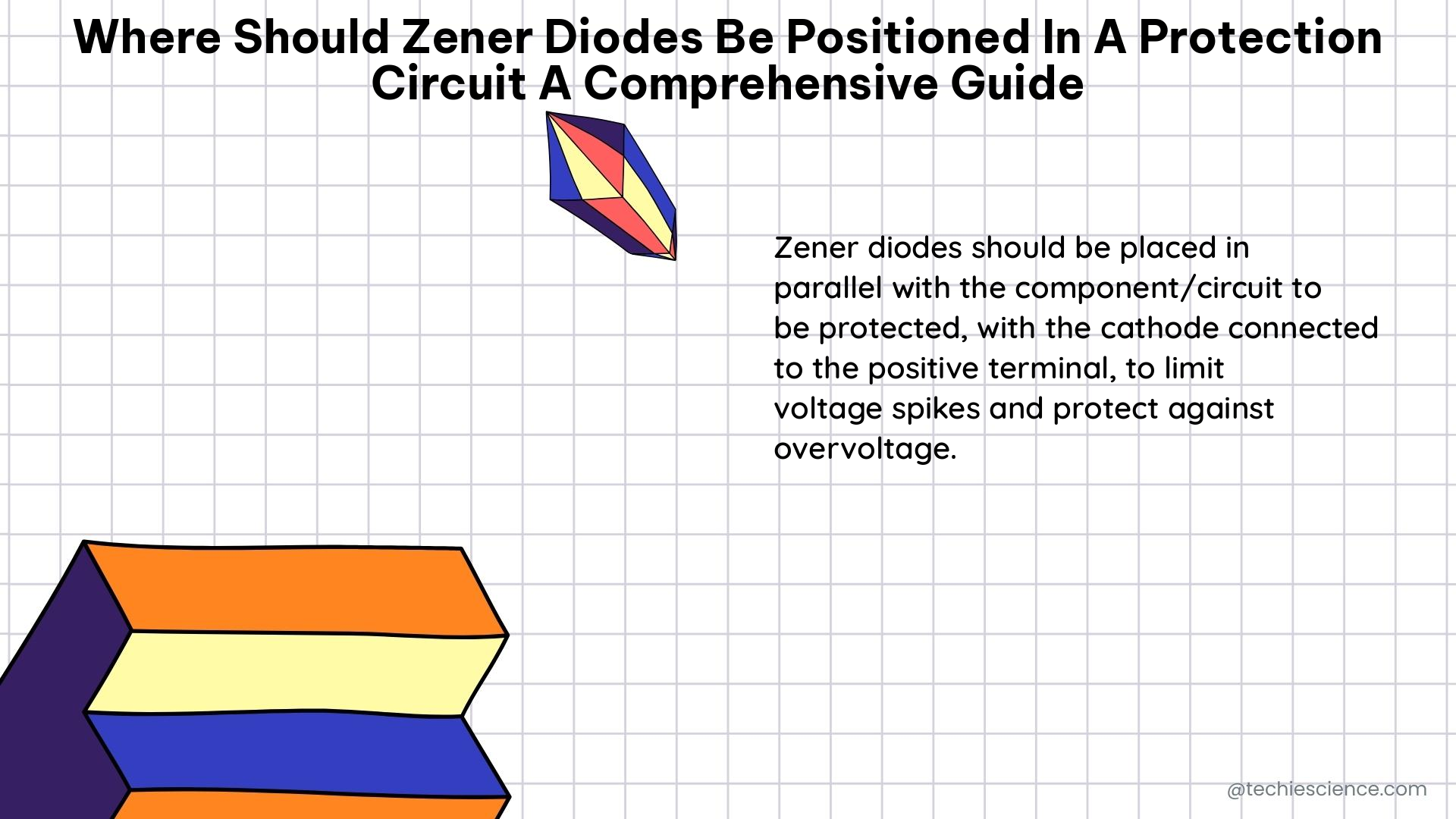Zener diodes are widely used in electronic circuits to provide overvoltage protection, voltage regulation, and other applications. Positioning the Zener diode correctly in a protection circuit is crucial to ensure effective and reliable operation. This comprehensive guide will delve into the details of where Zener diodes should be positioned in a protection circuit, along with the associated formulas, examples, and data points to help you understand the concept thoroughly.
Positioning Zener Diodes in a Protection Circuit
The primary rule for positioning Zener diodes in a protection circuit is to place them in parallel with the component or circuit that needs protection. This configuration allows the Zener diode to shunt any excess voltage away from the protected component, effectively limiting the voltage across it.
To further enhance the protection, a series resistor should be added in the circuit to limit the current passing through the Zener diode. This resistor serves to prevent the Zener diode from being overloaded and potentially damaged.
Choosing the Zener Diode Voltage Level

The value of the Zener diode should be chosen based on the voltage level that needs to be protected against. The Zener diode voltage should be slightly higher than the maximum voltage that the protected component can withstand. This ensures that the Zener diode will only conduct and provide protection when the voltage exceeds the desired threshold.
For example, if a circuit needs protection against overvoltage conditions up to 7V, a 6.8V Zener diode can be chosen as it is the nearest usable targeted Zener diode voltage.
Calculating the Power Rating of the Zener Diode
The power rating of the Zener diode is an important consideration for proper heat dissipation. The power rating can be calculated using the following formula:
Power rating of Zener diode = Voltage of Zener diode x Total current flowing through the diode
In the example mentioned earlier, if the load current linked across the circuit of overvoltage safety is 50mA, and the total current, plus the Zener diode biasing current, should be equal to the load current, the power rating of the Zener diode would be:
Power rating = 6.8V x 0.050A = 0.34W
It is essential to choose a Zener diode with a power rating that can handle the calculated power dissipation to ensure reliable operation and prevent thermal issues.
Calculating the Series Resistor Value
The value of the series resistor should be calculated based on the maximum current that can flow through the Zener diode. The formula for calculating the resistor value is:
Value of resistor = (Voltage of source – Voltage of Zener diode) / Total current flowing through the diode
For example, if the source voltage is 13V and the Zener diode voltage is 6.8V, the voltage drop through the resistor will be 13V – 6.8V = 6.2V. Assuming the total current flowing through the diode is 60mA, the resistor value can be calculated as:
Resistor value = 6.2V / 0.060A = 103Ω
In this case, a standard 100Ω resistor can be used.
Data Points and Facts
- Zener diodes should be positioned in a protection circuit in parallel with the component or circuit that needs protection.
- A series resistor should be added to limit the current passing through the Zener diode.
- The value of the Zener diode should be chosen based on the voltage level that needs to be protected against.
- The power rating of the Zener diode should be considered for proper heat dissipation.
- The value of the series resistor should be calculated based on the maximum current that can flow through the Zener diode.
- The total current, including the Zener diode biasing current, should be equal to the load current.
- Choosing the appropriate Zener diode voltage level is crucial for effective protection.
- Calculating the power rating of the Zener diode ensures reliable operation and prevents thermal issues.
- Calculating the value of the series resistor based on the maximum current flow through the Zener diode is essential for limiting the current.
Conclusion
In summary, positioning Zener diodes correctly in a protection circuit is a critical step in ensuring effective and reliable overvoltage protection. By following the guidelines outlined in this comprehensive guide, you can design robust protection circuits that can safeguard your electronic components from potentially damaging voltage spikes and surges.
References
- How to Use a Zener Diode to Protect ADC, MCU Analog Inputs
- Zener Diode Applications: Circuit Protection
- How Does Zener Diode Do Overvoltage Protection in Circuit
- Resistor Placement for Zener Diode for Over-Voltage Protection
- Beginner’s Guide to ESD Protection Circuit Design for PCBs

The lambdageeks.com Core SME Team is a group of experienced subject matter experts from diverse scientific and technical fields including Physics, Chemistry, Technology,Electronics & Electrical Engineering, Automotive, Mechanical Engineering. Our team collaborates to create high-quality, well-researched articles on a wide range of science and technology topics for the lambdageeks.com website.
All Our Senior SME are having more than 7 Years of experience in the respective fields . They are either Working Industry Professionals or assocaited With different Universities. Refer Our Authors Page to get to know About our Core SMEs.